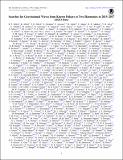Searches for Gravitational Waves from Known Pulsars at Two Harmonics in 2015–2017 LIGO Data
Author(s)
LIGO Scientific Collaboration; Virgo Collaboration
DownloadPublished version (3.796Mb)
Publisher Policy
Publisher Policy
Article is made available in accordance with the publisher's policy and may be subject to US copyright law. Please refer to the publisher's site for terms of use.
Terms of use
Metadata
Show full item recordAbstract
© 2019. The American Astronomical Society. All rights reserved.. We present a search for gravitational waves from 222 pulsars with rotation frequencies 10 Hz. We use advanced LIGO data from its first and second observing runs spanning 2015-2017, which provides the highest-sensitivity gravitational-wave data so far obtained. In this search we target emission from both the l = m = 2 mass quadrupole mode, with a frequency at twice that of the pulsar's rotation, and the l = 2, m = 1 mode, with a frequency at the pulsar rotation frequency. The search finds no evidence for gravitational-wave emission from any pulsar at either frequency. For the l = m = 2 mode search, we provide updated upper limits on the gravitational-wave amplitude, mass quadrupole moment, and fiducial ellipticity for 167 pulsars, and the first such limits for a further 55. For 20 young pulsars these results give limits that are below those inferred from the pulsars' spin-down. For the Crab and Vela pulsars our results constrain gravitational-wave emission to account for less than 0.017% and 0.18% of the spin-down luminosity, respectively. For the recycled millisecond pulsar J0711-6830 our limits are only a factor of 1.3 above the spin-down limit, assuming the canonical value of 1038 kg m2 for the star's moment of inertia, and imply a gravitational-wave-derived upper limit on the star's ellipticity of 1.2 × 10-8. We also place new limits on the emission amplitude at the rotation frequency of the pulsars.
Date issued
2019Department
LIGO (Observatory : Massachusetts Institute of Technology); Massachusetts Institute of Technology. Department of Physics; MIT Kavli Institute for Astrophysics and Space ResearchJournal
Astrophysical Journal
Publisher
American Astronomical Society